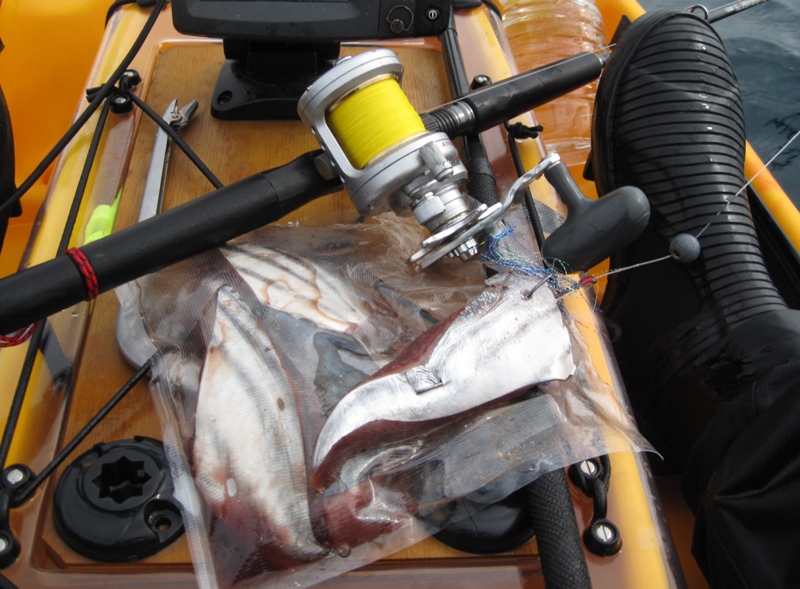Hunting big fish out of the kelp and Big fish out deeper this winter
12:28AM 17th May 14
Old School Techniques on latest generation setups
Now the colder months are here and water temperatures are dropping I thought I’d take a step back in time and revisit some of the fishing systems and areas I started with when first getting into kayak fishing. I had a gentle reminder of just how good some of these classic “lob big baits, catch big fish” techniques can be during the recent Taranaki Kayak Classic.
On day two of the tournament the windy and choppy conditions along our chosen part of the coast forced us to stay in close. As a result my team mate and I chose to anchor and berley before lobbing baits down the wind driven current in shallow water. The ensuing action reminded me of my kayak fishing roots and also resulted in a couple of trips to the podium during prize giving!
Another reason for revisiting techniques using cut and strip baits is the brilliant summer I’ve had chasing tuna. This season has seen numerous albacore and skipjack come aboard the kayak, and while albacore never make it past the frying pan I’ve been able to get some of the skippies properly prepared and secretly frozen. These, along with a variety of fresh kahawai, jack mackerel, and trevally baits will form the basis of my winter fishing.

Summer skippies quickly iced down to keep them in prime condition before filleting produce magical cut baits. The secret is to prepare and vacuum bag the baits before freezing so they thaw nice red and juicy.
Back to the beginning
When I first started kayak fishing it was impossible to find any other “crazies” out chasing snapper and kings along the coast from plastic toothpicks (oh how that’s changed, now it’s almost kayaks everywhere you turn). As a result I had to discover for myself the best techniques and where to hunt fish. Since my salt water angling background to that point was primarily land-based my first kayak expeditions were targeted at familiar areas with proven productivity from the rocks.
Initially I started with finding suitable launching sites within close range of my land-based haunts, then paddling in close to drop the pick. On top of the anchor chain resided the obligatory block of frozen berley; typically a massive block consisting of a “secret brew” of mash, fish oil, and frames. It would quickly slick the area I’d begin lobbing big cut baits and butterflied mackerel around the gutters and kelp lines.
There was often some wry amusement associated with this. As a land based angler I’d sneak around on the rocks and regularly lob the best baits as floaters as far out the back and away from the rocks as possible. Now I was doing the complete opposite, paddling (and still sneaking as quietly as possible) into the same locations, but now lobbing my baits as close to the rocks as possible.
A little patience while soaking up the winter sun and drifting floating cut baits around wash zones will produce exciting battles with big snapper. Kayaks are key to accessing this kind of daytime fishing as they don’t disturb fish and let you sneak into areas boaties fear to tread.
Lessons learned
New to this kayak fishing lark I quickly discovered the importance of keeping baits from fouling in the kelp. I also discovered that multiple hookups in lumpy conditions close to the wash zone can be enormously “exciting”. It was in these situations I learned to appreciate kayaks with excellent primary stability (kayaks that sit stable and flat on the water without too much rock and roll). More twitchy craft can quickly become a handful when anchored and a large fish drags you into the surge or turns you side-on to the conditions. Of course, to complicate matters this is invariably when the anchor gives you a lurch and tries to drag the stern under!
Another challenge that quickly showed was the need to instantly get the fishes head up, and to keep it up at almost any cost. Snapper and trevally in particular will have you in the kelp in an instant if you give them their head, and it’s a fine balancing act trying to apply maximum pressure, stay upright on the kayak, and get a green fish to the net or gaff without going for an unplanned swim.
On a purely personal note, this is a large part of what addicted me to kayak fishing. Sneaking around trying to tempt a big fish into eating something attached to my line, then the frenetic battles and adrenalin rush of trying to land crazily big fish from skinny boats in shallow water. This wasn’t at all like having chunk of rock on which to plant your feet or the corner of a large cockpit to wedge yourself in, it’s a pure rush!
Northland waters can occasionally produce solid blue cod like this 42cm Whangarei Heads fish, the trick is getting the big baits past marauding snapper.
Back to the future
A couple of decades on, the challenge over the next few months will be to find out what’s changed and whether the big fish that started this crazy addiction are still there and willing to eat big baits. Certainly there have been incredible advancements with the kayaks we use: greater stability, improved performance, fantastically better storage for tackle, bait, and catch.
The tackle has also seen significant improvements. Most notable is the ready availability of kelp-busting braid lines along with smaller framed reels with the strength and drag performance to fish them to the max. These have had a huge impact on the pressure we can put on fish at close quarters, and the reduced bulk makes a considerable difference in a kayak to our ability to track big fish with the rod tip.
As recent competition successes suggest, the fish are there, they’re willing, so let’s spend the next couple of months exploring the modern version of kayak fishing 1990’s style.
Strapped down and ready for launch, this is some of the tackle I’m using to mix it up with big fish on baits. Fixed spool reels with heavier lines for cast baits in close, free spool reels let me stray line with great sensitivity
Select your weapons
Fishing close to the coast changes the emphasis on what are the most important features of a rod, reel, and line combo. This is close combat fishing amongst the rocks and kelp, and there’ll be no taking prisoners. While I get huge delight from fishing deeper water with cobwebs they aren’t suited to the style of fishing we’re talking about here. For this winter project I’ve up spec’d and am running 10 – 15kg braid from my free spool reels, and 15 – 24kg braid from my fixed spools.
There are a number of reasons for these choices:
- In my experience there’s very little difference kg for kg between top quality braids and monofilaments when it comes to surviving abrasion on the rocks, but braid copes with kelp considerably better than mono.
- The fine diameter and textured surface created by the weave allows it to slice through kelp much more easily than mono.
- Most braids float slightly (most mono’s sink), so when working unweighted baits around kelp braid is less likely to sink into the top leafy layers impeding the drift of the bait and then becoming tangled.
- The finer diameter of braid lines also reduces water resistance to improve the presentation of the bait and makes the drift look more natural.
- Stepping up in breaking strain allows greater latitude with knot performance, especially with the critical braid to leader joint. In the hurly burley of a frenetic snapper attack and then its mad dash to get away there can often be considerable shock loading on knots. Combine this with the potential for less than perfect knots after the inevitable re-rig and the buffer provided by stronger lines is greatly appreciated.
- For my free spool reels I choose slightly lighter lines because I use them primarily for straylining from the side of the kayak (not casting). This means line angles are usually more vertical, making it harder for fish to part the line on structure. Using finer line improves bait presentation and sensitivity for detecting soft takes.
- My fixed spool reels are rigged with heavier braid as these are the outfits I use when lobbing baits in close to the rocks, around structure, and up gutters. In these situations line angles are shallow and the heavier braid offers greater protection from rocks and kelp. Another critical advantage is that heavier lines allow me to winch the kayak to the fish, getting over top of it as quickly as possible to minimizing the risk of a reefing.
Pre tying terminal tackle is critical when fishing country that could see you re-rigging on a regular basis. Big hooks for big baits, smaller rigs for finesse presentations, livebait rigs just in case; be prepared for any eventuality.
When selecting reels to match these lines I look for those with drags rated to cope with the pressure braid will put them under. The critical feature is the drag must remain smooth without any jerk on start-up at all. This allows us to apply maximum pressure to keep the fishes head up without (hopefully) ending up in the water, and all this action is going to be happening very quickly because you’re close to the fish. Remember, a jerky drag could just as easily have you falling backwards off the kayak at the sudden pressure release as it could have you dragged in after the fish if the drag binds.
Choosing the rod is the final step before heading out to do battle. Since we’re fishing from kayaks cast distance isn’t as important compared to trying to target the same areas from larger craft. We’re able to sneak in amongst the structure putting us closer to our quarry, so again the main issue is being able to maximize the pressure on the fish but stay aboard. For me this means using shorter rods up to 6’ in the heavier line classes and 6’6” in the lighter 10kg class. Shorter rods reduce the leverage the fish has and makes it much easier to use rod angles to control proceedings.
Rod action is also incredibly important: soft tips reduce shock loading and make casting easier, strong mid-to-butt sections allow us to load the pressure on the fish. Another critical discovery I’ve made is that the reel seats on the rods must be up to the task, especially for fixed spool reels. Heavy cranking with these applies a lot of sideways pressure and torque, if the hoods on the seat aren’t up to the task the reel can quickly work loose causing major problems.
Winter can produce spectacular days for chasing fat table fish. With paddling conditions like this there’s no excuse for not getting out there when fishing north of 38° South!
Over the next couple of months I’ll continue with hunting big fish out of the kelp and getting big baits to all depths in our winter waters. Let’s see what the latest generations of kayaks, tackle, and techniques can land us…









